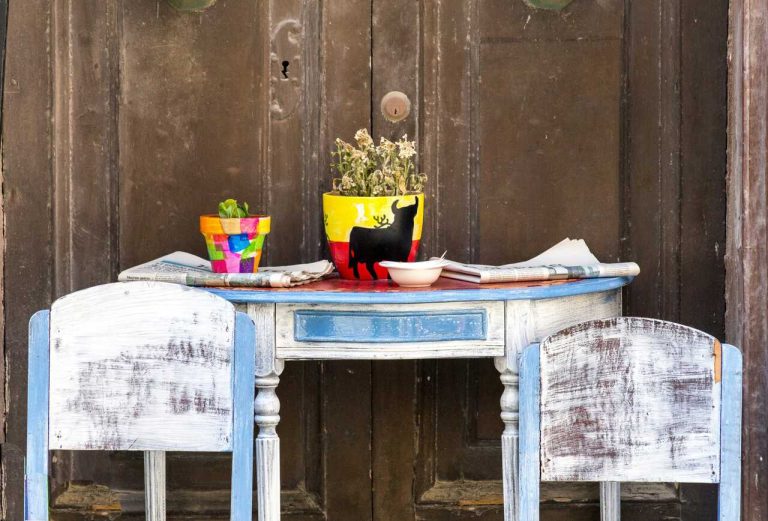
Estar Conjugation Chart: Spanish Beginner Verbs
DATE:
Today we’re getting down to the basics of Spanish grammar by talking about one of the very first verbs you’ll need to master in your Spanish-learning journey.
The Spanish verb Estar is one of the most important verbs in the language, and you’ll be using it all the time – so it’s important to learn how to master it ASAP.
So we’re keeping things simple today with the Estar conjugation chart, so you’ll always be ready to use this helpful verb in all tenses.
Present Tense
You’re probably already familiar with the present indicative tense for Estar, but doing some reviewing never hurt anyone! It’s a highly irregular verb form, just like most basic verbs.
We’re going to start off strong by going through the present indicative form of the verb:
|
Subject Pronoun |
Estar |
|---|---|
|
Yo |
Estoy |
|
Tú / Vos |
Estás |
|
Él / Ella / Usted |
Está |
|
Nosotros |
Estamos |
|
Vosotros |
Estáis |
|
Ellos / Ellas / Ustedes |
Están |
As you can see – the yo form is completely irregular and the endings for the second and third person always have accent marks. This is different from most regular -AR verbs, so it’s absolutely a unique case.
Let’s look at a couple of examples with these verbs:
- ¿Dónde está el restaurante? – Where is the restaurant?
- ¿Están listos para empezar? – Are they ready to start?
- Estoy demasiado cansada para ir a trabajar. – I’m too tired to go to work.
These are a couple of simple, but very important forms for the Estar conjugation. Make sure you have this mastered before moving on to the next stage!
Estar listo is very different from Ser listo. If you need help distinguishing these two verbs, check out our article on Ser vs Estar.
Imperfect Tense
We’re going to start off this next section with some great news:
Estar is a regular verb in the imperfect tense! Meaning the Estar conjugation is just like any other –AR verb. So it shouldn’t take long at all to master the verb Estar for this tense.
All you need to do is remove the stem, and then add the –aba endings, like in this chart:
|
Subject Pronoun |
Estar |
|---|---|
|
Yo |
Estaba |
|
Tú / Vos |
Estabas |
|
Él / Ella / Usted |
Estaba |
|
Nosotros |
Estábamos |
|
Vosotros |
Estabais |
|
Ellos / Ellas / Ustedes |
Estaban |
As you can see – you shouldn’t have any problems at all using Estar in the imperfect tense! For once, this very common Spanish verb is actually regular! That doesn’t happen often, so it’s definitely something to celebrate.
So even though this Estar conjugation is simple, let’s look a couple examples:
- Las llaves no estaban en la mesa. – The keys weren’t on the table.
- Estábamos mirando pisos para alquilar. – We were looking at apartments to rent.
Preterite Tense
Unfortunately, not every Estar conjugation is going to be easy. To conjugate the verb Estar in the preterite tense, we’re going to have to go back to memorizing an irregular verb chart. Here’s what it looks like:
|
Subject Pronoun |
Estar |
|---|---|
|
Yo |
Estuve |
|
Tú / Vos |
Estuviste |
|
Él / Ella / Usted |
Estuvo |
|
Nosotros |
Estuvimos |
|
Vosotros |
Estuvisteis |
|
Ellos / Ellas / Ustedes |
Estuvieron |
The verb Estar has a stem form that changes to Estuv–. This is highly irregular, considering there are only two Spanish verbs that do this: Estar and Andar. So like always, the best way to handle this situation is by simply practicing it as much as possible!
- No estuve en casa este fin de semana pasado. – I wasn’t home this weekend.
- Estuvimos en el concierto en ese momento. – We were at the concert at that time.
This ultimate guide of the Estar preterite conjugations covers everything you need to know to master this difficult tense. Make sure to check that guide if you’re having trouble with the Estar conjugation.
Future Tense
Here’s another great example of the verb Estar being used just like any other -AR verb. The future tense is usually one of the easiest tenses for any verb, and that stays true here, as well.
For -AR verbs, all you need to do is add to the base verb, so it’s pretty easy to remember. It should look like this:
|
Subject Pronoun |
Estar |
|---|---|
|
Yo |
Estará |
|
Tú / Vos |
Estarás |
|
Él / Ella / Usted |
Estará |
|
Nosotros |
Estaremos |
|
Vosotros |
Estaráis |
|
Ellos / Ellas / Ustedes |
Estarán |
For this verb form, you don’t have any irregularities. The future tense is very beginner-friendly, especially since you don’t have too much you need to worry about!
Here’s a couple easy examples:
- ¿Estarás en Guadalajara en abril? – Will you be in Guadalajara in April?
- Estarán allí en diez minutos – We’ll be there in ten minutes
Want to see just how easy it is to master the future tense in Spanish? Check out our guide!
Subjunctive Present Tense
Now we’re going to be moving on to some of the more difficult Spanish topics. The subjunctive mood tends to give learners problems – no matter what the verb.
While today we’re not focusing on the meaning behind the subjunctive, just the conjugation form. In that aspect, the verb Estar isn’t so difficult.
Like it is in many other tenses, it’ll be irregular in the present subjunctive. Here, make sure to pay close attention to the accent marks:
|
Subject Pronoun |
Estar |
|---|---|
|
Yo |
Esté |
|
Tú / Vos |
Estés |
|
Él / Ella / Usted |
Esté |
|
Nosotros |
Estemos |
|
Vosotros |
Estéis |
|
Ellos / Ellas / Ustedes |
Estén |
This verb is special in that you’ll need to include accent marks for every form except the first person plural (nosotros). This is super important as it makes the difference between este (this) and esté (is).
Let’s look at some examples of how to use the present subjunctive with Estar.
- Me alegro de que estén bien – I’m happy they’re well
- No creo que esté muy lejos ya – I don’t think it’s very far now
- Lo importante es que estemos juntos – What’s important is that we’re all together
Imperfect Subjunctive Tense

Let’s move on to what is – by far – the most difficult way to use this Spanish verb. The imperfect subjunctive is a tricky conjugation that requires a lot of practice.
To make it worse, there are always two different forms of the verb. Luckily, you can use whichever one you like. But nonetheless, you still have two different forms you need to memorize.
|
Subject Pronoun |
Estar |
|---|---|
|
Yo |
Estuviera / Estuviese |
|
Tú / Vos |
Estuvieras / Estuvieses |
|
Él / Ella / Usted |
Estuviera / Estuviese |
|
Nosotros |
Estuviéramos / Estuviésemos |
|
Vosotros |
Estuvierais / Estuvieseis |
|
Ellos / Ellas / Ustedes |
Estuvieran / Estuviesen |
In most cases – the two forms are up to personal preference. You can use either version of this Spanish verb that you prefer without changing the meaning.
Now let’s look at some examples of how to use Estar in this form:
- Ojalá estuviera mi padre. – I wish my father were here.
- Si estuviésemos en Italia, tendríamos más días de vacaciones. – If we were in Italy, we’d have more vacation days.
Compound Forms
Let’s move on to the final piece of the puzzle. The past participle and gerund forms are absolutely essential in forming a variety of different verb tenses. Let’s take a quick look at the two:
- Estar Participle – Estado
- Estar Gerund – Estando
Once you have those two verbs, you’ll be able to use it to form a variety of compound form verbs. When you use the past participle, Estar usually goes with an auxiliary verb like Haber.
There are actually many different ways you can use the verb like this, but they’re all very similar. So let’s break them down into sections:
Perfect tenses
The perfect tenses are similar to those in English. For a quick review, they’re the equivalent to “I have been / I had been / I will have been”.
Although they’re not used exactly the same way as in English, it’s a helpful starter. Here, we’ll conjugate the verb Haber to match the subject, but we always keep the participle form of the verb throughout. Let’s look at the chart:
|
Spanish |
Pretérito perfecto |
Pluscuamperfecto |
Futuro perfecto |
|---|---|---|---|
|
Yo |
He estado |
Había estado |
Habré estado |
|
Tú / Vos |
Has estado |
Habías estado |
Habrás estado |
|
Él / Ella / Usted |
Ha estado |
Había estado |
Habrá estado |
|
Nosotros |
Hemos estado |
Habíamos estado |
Habremos estado |
|
Vosotros |
Habéis estado |
Habíais estado |
Habréis estado |
|
Ellos / Ellas / Ustedes |
Han estado |
Habían estado |
Habrán estado |
As you can see, the only thing that changes throughout is the verb Haber. Of course each of these perfect tenses has their own meaning and usages, but for today – we won’t get caught up in all that!
So let’s look at a few examples:
- Ella nunca había estado en California. – She had never been in California.
- Sí, hemos estado alguna vez. – Yeah, we’ve been (there) at some point.
- Me imagino que ya habrán estado. – I imagine they’ve probably already been there.
The perfect tenses aren’t always easy to understand right away – even if they’re easy to use! So check out our guide on the past perfect tense if you want to avoid any confusion!
Subjunctive and conditional tenses
Finally, let’s move on to the subjunctive and conditional tenses. Once again, they might not be super easy to understand right away – but the conjugations are pretty simple!
So let’s dive into the easy part:
|
Spanish |
Pretérito perfecto |
Pluscuamperfecto |
Condicional |
|---|---|---|---|
|
Yo |
Haya estado |
Hubiera estado |
Habría estado |
|
Tú / Vos |
Hayas estado |
Hubieras estado |
Habrías estado |
|
Él / Ella / Usted |
Haya estado |
Hubiera estado |
Habrías estado |
|
Nosotros |
Háyamos estado |
Hubiéramos estado |
Habría estado |
|
Vosotros |
Hayais estado |
Hubiérais estado |
Habríais estado |
|
Ellos / Ellas / Ustedes |
Hayan estado |
Hubiera estado |
Habrían estado |
Just like the previous perfect tenses, these ones are formed using the verb Haber, then maintain the participle form for Estar. Here are a few examples of it in use:
- Dudo que haya estado nunca. – I doubt he’s ever been (there).
- Si hubieras estado, sabrías que había que limpiar. – If you had been there, you would have known that you had to clean.
- Si los hubieras avisado antes, habrían estado listos. – If you had warned them earlier, they would have been ready.
¡Ya está!
The last little use of Estar – you’re done! This is one Spanish verb that you’re going to be using a LOT. So the sooner you master it, the better!
So you might as well go ahead and sign up for a free private class or a 7-day free trial of our group classes to practice what you learned!








